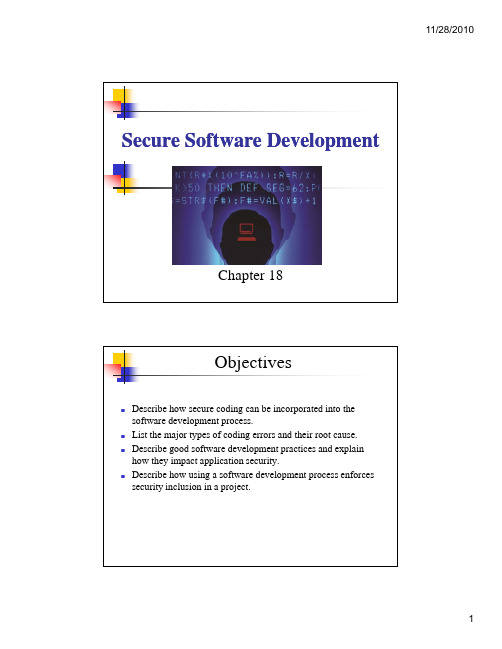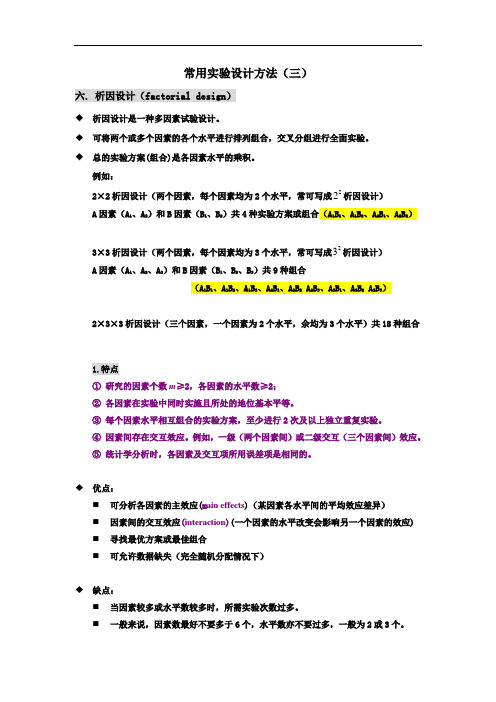flexible_factorial_design_specification_Glascher_Gitelman(2008)
- 格式:pdf
- 大小:155.25 KB
- 文档页数:12



fractional factorial conjoint
我们要了解fractional factorial conjoint的含义。
首先,我们需要了解什么是fractional factorial design和conjoint analysis。
Fractional factorial design是一种实验设计方法,用于在有限的资源下进行多因素实验。
Conjoint analysis是一种统计方法,用于研究产品或服务的不同属性如何影响消费者对产品的整体评价。
当我们结合这两种方法时,我们得到fractional factorial conjoint。
这种方法允许我们同时考虑多个因素及其交互作用,并确定哪些因素对产品的整体评价有显著影响。
为了更好地理解fractional factorial conjoint,我们可以考虑一个简单的例子:
假设我们正在测试两种不同品牌的手机,每种手机都有三个属性:价格、屏幕大小和电池寿命。
使用fractional factorial conjoint,我们可以设计实验来同时测试所有可能的属性组合,并确定哪些属性组合对消费者的购买决策有最大影响。
总结:Fractional factorial conjoint是一种结合了fractional factorial design和conjoint analysis的方法,用于在有限的资源下研究多个因素及其交互作用对产品整体评价的影响。

六西格玛培训—改进阶段模块部分因子设计Patrick ZhaoI&CIM Deployment Champion部分因子设计介绍创建部分因子设计分析部分因子设计其他部分因子(筛选)设计部分因子设计介绍创建部分因子设计分析部分因子设计其他部分因子(筛选)设计以因子水平的仅执行全因子确定了重要因特殊的响应曲使产品或过程试验设计类型全因子部分因子响应曲面混料田口试验目的全部组合度量响应的设计。
设计中的部分设计。
子后进行模型改进。
面试验,主要研究产品的多种成分组成。
在操作环境中更加稳定试验设计。
因子个数≤4≥5≤3 3 ~ 5≥7试验设计路线图部分因子设计•在分析初期对大量潜在因子做筛选,确定少量关键因子。
全因子设计•针对部分关键因子,全面分析各因子之间的交互作用。
响应曲面设计•对模型进行更深入分析,识别模型中的弯曲现象。
为了节省资源,一般采用其中两种设计就已经足够分析。
优点:大量减少试验组合数。
•对于一个2水平,6因子的试验设计,采用全因子和部分因子的试验组合数如下:全因子部分因子26=6412∗26=32 14∗26=16 18∗26=8缺点:只分析关键的因子效应,忽略部分交互效应。
•对于一个2水平,3因子的试验设计,采用全因子和部分因子在分析因子效应时的区别如下:全因子部分因子•主效应与两因子交互作用混杂,三因子交•所有效应均能被分析。
互作用不能被分析。
混杂•混杂发生于部分因子设计中,原因是设计中不包括因子水平的所有组合。
例如,如果因子A 与3 因子交互作用BCD 相混杂,则A 的估计效应是A 的效应与BCD 的效应的合计。
您无法确定显著效应是因为A、因为BCD,还是因为两者的组合。
•办公室上班族为了健康,办了健身卡,每周请私人教练2次进行锻炼。
•与此同时,开始控制饮食,每天科学摄入合理的卡路里。
•3个月后,身体状态感觉良好,体脂率下降3%。
此时,我们无法得知,到底是锻炼还是控制饮食对降低体脂率更有帮助,也无法得知这两种措施的影响程度分别有多少。


常用实验设计方法(三)六.析因设计(f a c t o r i a l d e s i g n)◆析因设计是一种多因素试验设计。
◆可将两个或多个因素的各个水平进行排列组合,交叉分组进行全面实验。
◆总的实验方案(组合)是各因素水平的乘积。
例如:2×2析因设计(两个因素,每个因素均为2个水平,常可写成22析因设计)A因素(A1、A2)和B因素(B1、B2)共4种实验方案或组合(A1B1、A1B2、A2B1、A2B2)3×3析因设计(两个因素,每个因素均为3个水平,常可写成23析因设计)A因素(A1、A2、A3)和B因素(B1、B2、B3)共9种组合(A1B1、A1B2、A1B3、A2B1、A2B2A2B3、A3B1、A3B2A3B3)2×3×3析因设计(三个因素,一个因素为2个水平,余均为3个水平)共18种组合1.特点①研究的因素个数m≥2,各因素的水平数≥2;②各因素在实验中同时实施且所处的地位基本平等。
③每个因素水平相互组合的实验方案,至少进行2次及以上独立重复实验。
④因素间存在交互效应。
例如,一级(两个因素间)或二级交互(三个因素间)效应。
⑤统计学分析时,各因素及交互项所用误差项是相同的。
◆优点:⏹可分析各因素的主效应(m a i n e f f e c t s)(某因素各水平间的平均效应差异)⏹因素间的交互效应(i n t e r a c t i o n)(一个因素的水平改变会影响另一个因素的效应)⏹寻找最优方案或最佳组合⏹可允许数据缺失(完全随机分配情况下)◆缺点:⏹当因素较多或水平数较多时,所需实验次数过多。
⏹一般来说,因素数最好不要多于6个,水平数亦不要过多,一般为2或3个。
2.析因设计的类型➢可采用完全随机分配方法或随机区组的析因设计。
➢可安排两因素或多因素实验⑴2×2析因设计结果见下表:分析:设计类型?如何制定设计方案?如何进行统计学分析?①设计类型两个因素:甲药(不用、用),乙药(不用、用),交叉全面组合,各实验方案独立重复3次,为2×2析因设计。
Factorial experimentIn statistics, a full factorial experiment is an experiment whose design consists of two or more factors, each with discrete possible values or "levels", and whose experimental units take on all possible combinations of these levels across all such factors. A full factorial design may also be called a fully crossed design. Such an experiment allows studying the effect of each factor on the response variable, as well as the effects of interactions between factors on the response variable.For the vast majority of factorial experiments, each factor has only two levels. For example, with two factors each taking two levels, a factorial experiment would have four treatment combinations in total, and is usually called a 2×2 factorial design.If the number of combinations in a full factorial design is too high to be logistically feasible, a fractional factorial design may be done, in which some of the possible combinations (usually at least half) are omitted.HistoryFactorial designs were used in the 19th century by John Bennet Lawes and Joseph Henry Gilbert of the Rothamsted Experimental Station.[1]Ronald Fisher argued in 1926 that "complex" designs (such as factorial designs) were more efficient than studying one factor at a time.[2] Fisher wrote,"No aphorism is more frequently repeated in connection with field trials, than that we must ask Nature few questions, or, ideally, one question, at a time. The writer is convinced that this view is wholly mistaken." Nature, he suggests, will best respond to a logical and carefully thought out questionnaire". A factorial design allows the effect of several factors and even interactions between them to be determined with the same number of trials as are necessary to determine any one of the effects by itself with the same degree of accuracy.Frank Yates made significant contributions, particularly in the analysis of designs, by the Yates analysis.The term "factorial" may not have been used in print before 1935, when Fisher used it in his book The Design of Experiments. [3]ExampleThe simplest factorial experiment contains two levels for each of two factors. Suppose an engineer wishes to study the total power used by each of two different motors, A and B, running at each of two different speeds, 2000 or 3000 RPM. The factorial experiment would consist of four experimental units: motor A at 2000 RPM, motor B at 2000 RPM, motor A at 3000 RPM, and motor B at 3000 RPM. Each combination of a single level selected from every factor is present once.This experiment is an example of a 22 (or 2x2) factorial experiment, so named because it considers two levels (the base) for each of two factors (the power or superscript), or #levels#factors, producing 22=4 factorial points.Designs can involve many independent variables. As a furtherexample, the effects of three input variables can be evaluated in eightexperimental conditions shown as the corners of a cube.This can be conducted with or without replication, depending on itsintended purpose and available resources. It will provide the effects ofthe three independent variables on the dependent variable and possibleinteractions.2×2 factorial experimentA B(1) − −a +−b − +ab ++To save space, the points in a two-level factorial experiment are often abbreviated with strings of plus and minus signs. The strings have as many symbols as factors, and their values dictate the level of each factor: conventionally, for the first (or low) level, and for the second (or high) level. The points in this experiment can thus berepresented as , , , and .The factorial points can also be abbreviated by (1), a, b, and ab, where the presence of a letter indicates that the specified factor is at its high (or second) level and the absence of a letter indicates that the specified factor is at its low (or first) level (for example, "a" indicates that factor A is on its high setting, while all other factors are at their low (or first) setting). (1) is used to indicate that all factors are at their lowest (or first) values.ImplementationFor more than two factors, a 2k factorial experiment can be usually recursively designed from a 2k-1 factorial experiment by replicating the 2k-1 experiment, assigning the first replicate to the first (or low) level of the new factor, and the second replicate to the second (or high) level. This framework can be generalized to, e.g., designing three replicates for three level factors, etc.A factorial experiment allows for estimation of experimental error in two ways. The experiment can be replicated, or the sparsity-of-effects principle can often be exploited. Replication is more common for small experiments and is a very reliable way of assessing experimental error. When the number of factors is large (typically more than about 5 factors, but this does vary by application), replication of the design can become operationally difficult. In these cases, it is common to only run a single replicate of the design, and to assume that factor interactions of more than a certain order (say, between three or more factors) are negligible. Under this assumption, estimates of such high order interactions are estimates of an exact zero, thus really an estimate of experimental error.When there are many factors, many experimental runs will be necessary, even without replication. For example, experimenting with 10 factors at two levels each produces 210=1024 combinations. At some point this becomes infeasible due to high cost or insufficient resources. In this case, fractional factorial designs may be used.As with any statistical experiment, the experimental runs in a factorial experiment should be randomized to reduce the impact that bias could have on the experimental results. In practice, this can be a large operational challenge. Factorial experiments can be used when there are more than two levels of each factor. However, the number of experimental runs required for three-level (or more) factorial designs will be considerably greater than for their two-level counterparts. Factorial designs are therefore less attractive if a researcher wishes to consider more than two levels.A factorial experiment can be analyzed using ANOVA or regression analysis . It is relatively easy to estimate the main effect for a factor. To compute the main effect of a factor "A", subtract the average response of all experimental runs for which A was at its low (or first) level from the average response of all experimental runs for which A was at its high (or second) level.Other useful exploratory analysis tools for factorial experiments include main effects plots, interaction plots, and a normal probability plot of the estimated effects.When the factors are continuous, two-level factorial designs assume that the effects are linear. If a quadratic effect is expected for a factor, a more complicated experiment should be used, such as a central composite design. Optimization of factors that could have quadratic effects is the primary goal of response surface methodology.Notes[1]Frank Yates and Kenneth Mather (1963). "Ronald Aylmer Fisher" (.au/coll/special//fisher/fisherbiog.pdf). Biographical Memoirs of Fellows of the Royal Society of London9: 91–120. .[2]Ronald Fisher (1926). "The Arrangement of Field Experiments" (.au/coll/special//fisher/48.pdf).Journal of the Ministry of Agriculture of Great Britain33: 503–513. .[3]/f.htmlReferences•Box, G.E., Hunter,W.G., Hunter, J.S., Statistics for Experimenters: Design, Innovation, and Discovery, 2nd Edition, Wiley, 2005, ISBN 0471718130Article Sources and Contributors4 Article Sources and ContributorsFactorial experiment Source: /w/index.php?oldid=430074649 Contributors: AS, AbsolutDan, AdmiralHood, Alansohn, Baccyak4H, Btyner, Chris Bainbridge, Chris the speller, DanielCD, DanielPenfield, Darkildor, Eric Kvaalen, Euyyn, Fbriere, Giftlite, Intgr, IrisKawling, Jayen466, John Bessa, Kiefer.Wolfowitz, Michael Hardy, Mira, NatusRoma, Nesbit,Nicoguaro, Qwfp, RichardF, Rlsheehan, Rouenpucelle, Rsolimeno, Shanes, Statwizard, Zvika, 21 anonymous editsImage Sources, Licenses and ContributorsFile:Factorial Design.svg Source: /w/index.php?title=File:Factorial_Design.svg License: Public Domain Contributors: NicoguaroLicenseCreative Commons Attribution-Share Alike 3.0 Unported/licenses/by-sa/3.0/。